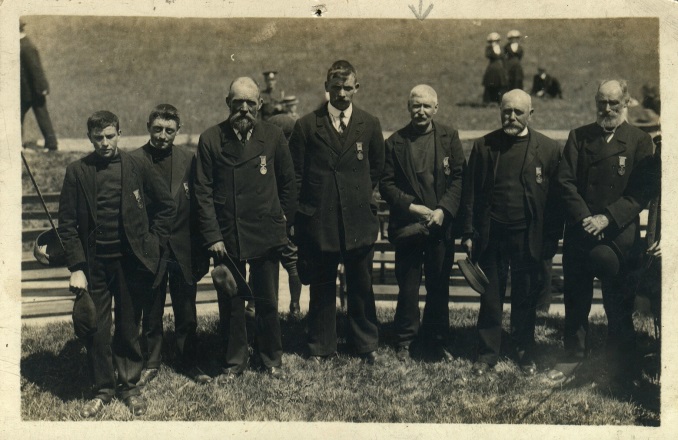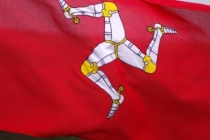Remembering Manx Rescuers at the Sinking of the Lusitania

The sinking of the luxurious liner Lusitania in just eighteen minutes off the Old Head of Kinsale in Ireland in 1915 by a German submarine resulted in the loss of 1,198 lives, but one of the first rescue vessels on the scene was a small Manx fishing boat PL11 Wanderer, from Peel on the west coast of the Isle of Man.
It was to be two hours before rescuers heading from the Irish mainland reached the scene, but the crew of the twenty ton lugger, Wanderer, fishing a few miles off Kinsale, with 800 mackerel on board, was alerted by Thomas Woods, after he saw the Lusitania listing. Steering the vessel, Woods was alone on deck, on watch, having sent little Johnny Macdonald below to make tea. The skipper of the Wanderer, Stanley Ball from Jurby, is reported to have said to Woods ‘Go for her, be British’.
Undeterred by the danger of enemy submarines, these brave Manxmen headed for the scene of the incident, and were soon within a quarter of a mile of the Lusitania; witnessing the horrifying spectacle of hundreds of people, many badly burned, fighting for their lives in the sea.
The crew of the Wanderer hauled on board 160 men, women and children, including a two month old baby, but others were clinging on to the sides of the vessel pleading for help; its heavy load pulling the boat low into the water.
As they sailed towards the Old Head of Kinsale, with fine weather and a calm sea, towing two lifeboats besides, the skipper and crew of the Wanderer offered comfort to the survivors with clothes, blankets, food and drink.
They included the industrial magnate, Mr D. A. Thomas, (The Right Honourable Viscount Rhondda of Cardiff), and his secretary, Mr A. L. Rhys Evans. So crammed was the lugger that Mr James Brooks, of Bridgeport, Connecticut, wrote:
I even had to sit with my leg hanging over the side because there was no room to put it on the inside.
Two miles from land the Wanderer was intercepted by an Admiralty tug, the Flying Fish, into which were transferred the devastated survivors, many of whom required urgent medical attention, before sailing for Queenstown (now renamed Cobh).
The Flying Fish docked to a hero’s welcome, but few realised the valiant role of the Wanderer, which returned to the site of the disaster, but found no further survivors.
It was difficult for some of the crew members of the Wanderer to come to terms with this war-time atrocity, reinforced by extracts from surviving letters, but their valiant act was recognised by members of the Manchester Manx Society who arranged for Mr F. S. Graves to design a special medal, which was presented to each of the crew by the Lieutenant Governor, Lord Raglan, on Tynwald Day 1915.
The names of the crew were:- William Ball (skipper) of Jurby, and his son, Stanley, William Gell of Ramsey, Thomas Woods, Robert Watterson, John Macdonald, and Harry Costain, (all of Peel). The vessel was owned by Mr Charles Morrison also of Peel.
The Wanderer was sold in 1918 and renamed Erin’s Hope, but on the way to the port of Baltimore in County Cork she was targeted by a U-boat and badly damaged. Rescued by a British naval cruiser some three hours later, the vessel was towed to Waterford for repair.
On a visit to Peel in July 1920, King George V enquired after the crew of the Wanderer, but was informed that they were away fishing and that the skipper had died a few months previously.
Meanwhile Erin’s Hope continued as a fishing boat until 1922, but was beached in Baltimore Lough, where she was fired on by British troops who mistakenly suspected the boat was used for gun running; later receiving compensation.
But whilst at anchor in a cove in 1926 Erin’s Hope was smashed to pieces by a sudden hurricane.
Margery West in her book, Island at War, recounts that there were several Manx passengers and crew aboard the Lusitania, not all of whom survived. Those who died were Walter Scott Quarrie of Douglas, a ventilating engineer on his first voyage, William Edward Christian, a Baker on his fourth voyage, also of Douglas, and Able Bodied Seaman Edward Fayle of Peel. Passenger Violet James, Seaman James Todd and T. Cornerforth or Comerford, a first-class bedroom steward, all of Douglas survived.
Extracts from Personal Letters of the Crew
The Skipper’s Letter to Mr Morrison:
….We had rather an exciting experience on Friday afternoon, about 2-30 p.m. We were coming in with about 800 mackerel, the wind light and ahead, and we put off to sea again for another shot, rather than lose the night. When we were six or seven miles off the Old Head we saw the Lusitania sink, after being torpedoed by a submarine, about three miles SSW. outside of us. We made straight for the scene of the disaster. We picked up the first boats a quarter of a mile inside of where she sunk, and there we got four boat loads put aboard us, We couldn't take any more, as we had 160-- men, women, and children. In addition, we had two boats in tow, full of passengers, We were the only boat there for two hours Then the patrol boats came out from Queenstown. We had a busy time making tea for them - and all our milk and tea is gone and a lot of clothes as well, and the bottle of whisky we had leaving home. The people were in a sorry plight, most of them having been in the water. We took them to within two miles of the Old Head, when it fell calm, and there was a little air ahead. The tug boat Flying Fish from Queenstown then came up and took them from us. . . . It was an awful sight to see her sinking, and to see the plight of these people. I cannot describe it to you in writing….
Thomas Woods:
….The saddest sight I ever saw in all my life. I cannot tell you in words, but it was a great joy to me to help the poor mothers and babes in the best way we could….
Harry Costain:
….We saw an awful sight on Friday. We saw the sinking of the Lusitania, and we were the only boat about at the time. We saved 160 people. and took them on our boat. I never want to see the like again. There were four babies about three months old, and some of the people were almost naked - just as if they had come out of bed. Several had legs and arms broken, and we had one dead man, but we saw hundreds in the water. I gave one of my changes of clothes to a naked man, and Johnny Macdonald gave three shirts and all his drawers….
Stanley Ball:
….We saw the Lusitania going east. We knew it was one of the big liners by her four funnels, so we put the watch on. We were lying in bed when the man on watch shouted that the four-funnelled boat was sinking. I got up out of bed and on deck, and I saw her go down. She went down bow first. We were going off south, and we kept her away to the S.S,W. So we went out to where it took place - to within a quarter of a mile of where she went down, and we picked up four yawls We took 110 people out of the first two yawls, and about fifty or sixty out of the next two; and we took two yawls in tow. We were at her a good while before any other boat. The first person we took on board was a child of two months. We had four or five children on board and a lot of women. I gave a pair of trousers, a waistcoat, and an oil-coat to some of them. Some of us gave a lot in that way. One of the women had her arm broke, and one had her leg broke, and many of them were very exhausted….
(Photo of the crew of the Wanderer courtesy of the Leece Museum in Peel)
Valerie Caine
© May 2014
- Manx
- English
- Log in to post comments





